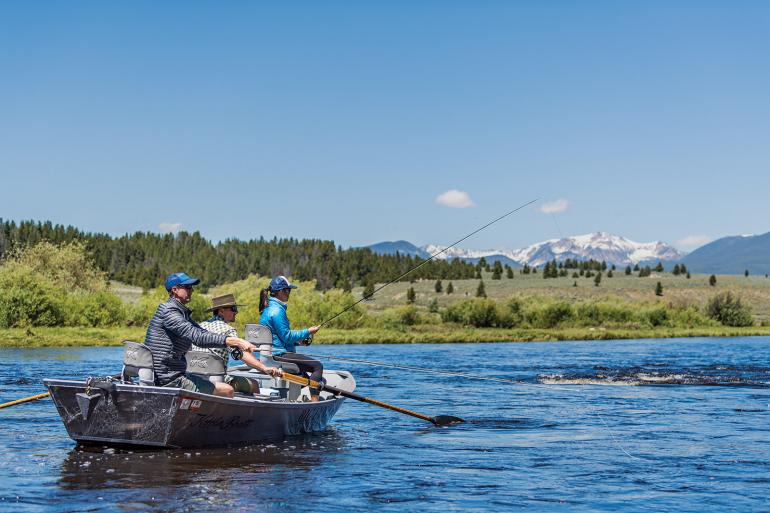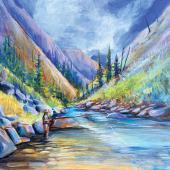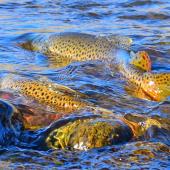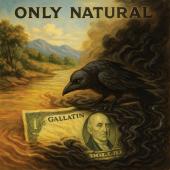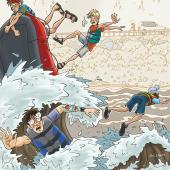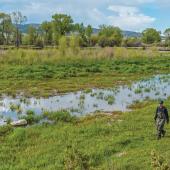Big Hole: River of Riches
A free-flowing trout haven.
You could say Montana’s Big Hole River has a bit of an identity crisis. From slow meadow sections to plunging canyon rapids, the Big Hole offers nearly everything a fly angler could ever want, yet no two sections are the same. Overshadowed at times by its more famous neighbors such as the Madison and the Missouri, the Big Hole is one of Montana’s most unique rivers, offering an abundance of excellent scenery, wildlife, and fly-fishing opportunities. Over its nearly 150-mile course, the Big Hole transitions from a small, high-mountain trickle with pockets of native arctic grayling into a strapping river full of deep runs, robust flows, and big brown trout. While southwest Montana has its share of fabled trout water, no others can match the diversity of the Big Hole, making it an outstanding gem in a state full of treasures.
Access
The Big Hole River is easily accessible from several towns in southwestern Montana, including Melrose, Divide, and Wise River. Much of the river in the lower section runs through private ranches, so staying below the high-water mark is a must while wading. There are, however, plenty of FWP and BLM access points, including several with campgrounds. The Salmon Fly access right outside of Melrose is a popular spot to camp and access the river.
Flows
The flow of the Big Hole River varies throughout the year, and anglers should be aware of the current conditions before planning a trip. The river is free-flowing, fed by snowmelt, and is typically at its highest in June and early July. During this time, the river can be difficult to fish due to high water levels and swift currents, although it can still be fishable in the upper stretches. In late summer and early fall, the water levels on the Big Hole River are generally lower, which makes for easier wading and more productive fishing, though the temperatures can often get too warm to fish in the afternoon. The fall months can also be a great time to fish for spawning browns, as they are more active and feeding heavily before the winter months.
When to Go
Aside from the depths of winter, the Big Hole can fish well throughout most of the year. The best time to fly fish the Big Hole, though, depends greatly upon the angler’s goals. If throwing large dry flies is the preferred method, the salmonfly hatch is a huge draw, typically occurring in late May or early June, when the river temperatures reach the mid-50s. The summer months are ideal for dry-fly fishing as well, and there are tons of caddis, mayflies, and stoneflies emerging. It’s also the busiest time on the Big Hole, and it can certainly get crowded during peak fishing season. The fall months are better for streamer fishing, as the fish are more aggressive and willing to chase larger flies, and the crowds disperse a bit as the weather turns.
Fish
The Big Hole is known for its diverse fish populations, including rainbow, brook, brown, and cutthroat trout—along with native arctic grayling and whitefish. Catching all six species in a single day is an outstanding accomplishment, and something that can only be done on a handful of rivers in Montana. Known for its population of large brown trout, the Big Hole’s other trout species can be equally as rewarding to target. Arctic grayling are native to Montana, and the Big Hole grayling are the only river-resident grayling in the Lower 48, providing anglers with a truly unique chance at catching a native Montana fish in its home waters.
Row vs. Wade
The Big Hole River can be fished by wading or floating, and both methods have their advantages and disadvantages. Wading allows anglers to access areas of the river that are not accessible by boat, and it allows for more precise casting and presentation of flies. Some stretches of the upper Big Hole are better for wading, as the water is smaller and more easily crossed on foot. Floating, on the other hand, allows anglers to cover more water and access areas of the river that are difficult to reach on foot. A popular float is from Divide to Melrose, through the Canyon section, and floats on the upper part of the river above Wise River allow anglers to experience different scenery and the chance at grayling.
Regs
The Big Hole is one of only a handful of rivers in Montana that is highly regulated when it comes to outfitting. Starting in May, certain sections are closed to outfitting and non-resident floating, leaving those sections more open to resident, recreational anglers. Be sure to check the regulations on each section beforehand if you’re planning a peak-season float. Additionally, all grayling must be released.
Getting There
From Bozeman, it takes a good two hours to get to the main section of the Big Hole. Simply head west on I-90 past Butte, then head south on I-15. To fish the upper stretches of the river, it’s a good idea to take the Divide exit and follow the river road up toward the town of Wise River. The lower reaches of the river can be fished and accessed below Divide.
John Van Vleet has fished Montana for more than two decades and is the marketing manager at the River’s Edge fly shop in Bozeman.

